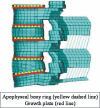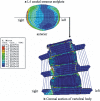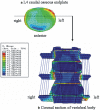Three-dimensional finite element analysis of the pediatric lumbar spine. Part I: pathomechanism of apophyseal bony ring fracture
- PMID: 16614857
- PMCID: PMC3489464
- DOI: 10.1007/s00586-005-1026-z
Three-dimensional finite element analysis of the pediatric lumbar spine. Part I: pathomechanism of apophyseal bony ring fracture
Abstract
The purpose of this study was to (1) develop a three-dimensional, nonlinear pediatric lumbar spine finite element model (FEM), and (2) identify the mechanical reasons for the posterior apophyseal bony ring fracture in the pediatric patients. The pediatric spine FE model was created from an experimentally validated three-dimensional adult lumbar spine FEM. The size of the FEM was reduced to 96% taking into account of the ratio of the sitting height of an average 14-years-old children to that of an adult. The pediatric spine was created with anatomically specific features like the growth plate and the apophyseal bony ring. For the stress analyses, a 10-N m moment was applied in all the six directions of motion for the lumbar spine. A preload of 351 N was applied which corresponds to the mean body weight of the 14-years-old group. The stresses at the apophyseal bony ring, growth plate and endplate were calculated. The results indicate that the structures surrounding the growth plate including apophyseal bony ring and osseous endplate were highly stressed, as compared to other structures. Furthermore, posterior structures in extension were in compression whereas in flexion they were in tension, with magnitude of stresses higher in extension than in flexion. Over time, the higher compression stresses along with tension stresses in flexion may contribute to the apophyseal ring fracture (fatigue phenomena).
Figures








Similar articles
-
Biomechanical rationale of ossification of the secondary ossification center on apophyseal bony ring fracture: a biomechanical study.Clin Biomech (Bristol). 2007 Dec;22(10):1063-7. doi: 10.1016/j.clinbiomech.2007.04.012. Epub 2007 Sep 25. Clin Biomech (Bristol). 2007. PMID: 17897759
-
Three dimensional finite element analysis of the pediatric lumbar spine. Part II: biomechanical change as the initiating factor for pediatric isthmic spondylolisthesis at the growth plate.Eur Spine J. 2006 Jun;15(6):930-5. doi: 10.1007/s00586-005-1033-0. Epub 2006 Apr 14. Eur Spine J. 2006. PMID: 16614856 Free PMC article.
-
Biomechanical rationale of sacral rounding deformity in pediatric spondylolisthesis: a clinical and biomechanical study.Arch Orthop Trauma Surg. 2011 Sep;131(9):1187-94. doi: 10.1007/s00402-010-1257-2. Epub 2011 Jan 9. Arch Orthop Trauma Surg. 2011. PMID: 21221610
-
A review of the pathomechanism of forward slippage in pediatric spondylolysis: the Tokushima theory of growth plate slippage.J Med Invest. 2015;62(1-2):11-8. doi: 10.2152/jmi.62.11. J Med Invest. 2015. PMID: 25817277 Review.
-
Abusive Pediatric Thoracolumbar Fracture Due to Forced Hyperextension: Case Report, Biomechanical Considerations, and Review of the Literature.J Forensic Sci. 2020 Nov;65(6):2023-2029. doi: 10.1111/1556-4029.14521. Epub 2020 Aug 17. J Forensic Sci. 2020. PMID: 32804424 Review.
Cited by
-
Skeletal growth and development dictate the processes of vertebral fracture in the pediatric spine; a review emphasizing fracture biomechanics of the vertebral body during the period of skeletal immaturity.Front Pediatr. 2025 May 8;13:1468926. doi: 10.3389/fped.2025.1468926. eCollection 2025. Front Pediatr. 2025. PMID: 40406355 Free PMC article. Review.
-
Bicortical Screw Purchase at Upper Instrumented Vertebra (UIV) Can Cause UIV Fracture After Adult Spinal Deformity Surgery: A Finite Element Analysis Study.Neurospine. 2020 Jun;17(2):377-383. doi: 10.14245/ns.1938100.050. Epub 2019 Jul 11. Neurospine. 2020. PMID: 31319661 Free PMC article.
-
A review of current treatment of lumbar posterior ring apophysis fracture with lumbar disc herniation.Eur Spine J. 2013 Mar;22(3):475-88. doi: 10.1007/s00586-012-2580-9. Epub 2012 Nov 21. Eur Spine J. 2013. PMID: 23179980 Free PMC article. Review.
-
Role of growth plate (apophyseal ring fracture) in causing modic type changes in pediatric low back pain patients.Eur Spine J. 2021 Sep;30(9):2565-2569. doi: 10.1007/s00586-021-06885-2. Epub 2021 May 26. Eur Spine J. 2021. PMID: 34037865
-
Biomechanical analysis of the lumbar spine on facet joint force and intradiscal pressure--a finite element study.BMC Musculoskelet Disord. 2010 Jul 5;11:151. doi: 10.1186/1471-2474-11-151. BMC Musculoskelet Disord. 2010. PMID: 20602783 Free PMC article.
References
-
- Arlet V, Fassier F. Herniated nucleus pulposus and slipped vertebral apophysis. In: Weinstein SL, editor. The pediatric spine. Philadelphia: Lippincott Williams & Wilkins; 2001. pp. 453–469.
-
- Goel VK, Lim T-H, Gwon J, et al. Effects of rigidity of an internal fixation device—a comprehensive biomechanical investigation. Spine. 1991;16(Suppl):S155–S161. - PubMed
-
- Goel VK, Monroe BT, Gilbertson LG, et al. Interlaminar shear stresses and laminae separation in a disc: finite element analysis of the L3-4 motion segment subjected to axial compressive loads. Spine. 1995;20:689–698. - PubMed
-
- Ikata T, Morita T, Katoh S, et al. Lesions of the lumbar posterior end plate in children and adolescents. An MRI study. J Bone Joint Surg [Br] 1995;77:951–955. - PubMed
MeSH terms
LinkOut - more resources
Full Text Sources
Medical

